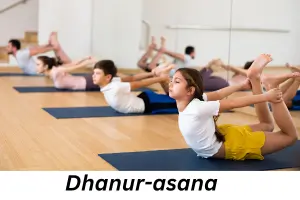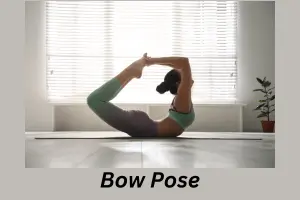
Introduction
Dhanurasana, also known as the “Bow Pose yoga” is one of the most significant postures in yoga.
Posture derives its name from the Sanskrit word “Dhanush” meaning “bow,” and “asana,” meaning “posture.”
When performed, the practitioner’s body resembles a bow, with the arms acting as the string and the legs as the bow itself.

Steps for Performing Dhanurasana (Bow Pose yoga)
- Lie on the Stomach:
Begin by lying down on your stomach with your legs stretched out and your arms resting by your sides. Keep your face facing downwards, resting your forehead gently on the floor. - Bend the Knees:
As you exhale, slowly bend your knees and bring your heels close to your hips. Reach your arms backward, and grasp the toes of your left foot with your left hand and the toes of your right foot with your right hand. - Lift the Chest and Legs:
Fully exhale and then pull your legs upward while lifting your chest off the ground. Raise your knees and thighs off the floor. The hands and arms act like a bowstring, creating tension to raise your legs and torso. - Arch the Back and Lift the Head:
Lift your head as far back as possible, creating a deep arch in your back. Ensure that your ribs and pelvic bones are not resting on the floor – only your abdomen should bear your body’s weight. - Align the Body:
Keep your legs slightly apart initially while lifting them. Once you achieve the full stretch, bring your thighs, knees, and ankles together for a more precise alignment. - Hold the Pose:
Maintain this posture for as long as comfortable, while breathing deeply. Focus on creating a smooth and even arch with your back and maintaining balance. - Release the Pose:
After holding the pose, exhale and gently lower your chest and legs back to the floor. Release your grip on your feet and relax.
Benefits of Dhanurasana
Practicing Dhanurasana offers several physical and mental benefits. By understanding the anatomical involvement, practitioners can maximize the benefits while minimizing the risk of injury.
1. Strengthens the Spine
Dhanurasana places considerable pressure on the spine, which helps in strengthening the vertebral bones. Regular practice makes the spine more elastic, which is particularly beneficial for people experiencing stiffness or discomfort in their back.
2. Improves Digestive Health
This posture exerts pressure on the abdominal region, massaging the stomach and digestive organs. It helps in releasing trapped gas, alleviating constipation, and improving digestion.
3. Relieves Constipation and Dyspepsia
By stretching the abdominal muscles and organs, Dhanurasana stimulates the digestive system, relieving common issues like constipation and indigestion.
4. Tones and Strengthens Muscles
The pose stretches and strengthens the muscles and nerves in the shoulders, arms, hands, thighs, and feet. It improves muscle tone and flexibility in these areas, helping build overall strength.
5. Restores Spinal Elasticity
For elderly individuals or those with rigid spines, Dhanurasana can restore elasticity. The backbend stretches the spine, promoting flexibility, which tends to decrease with age.
6. Alleviates Slipped Discs and Back Pain
Individuals suffering from slipped discs or mild back pain have found relief through regular practice of Dhanurasana. When combined with other asanas like Shalabhasana, it can help in managing back issues without resorting to surgery or prolonged bed rest.
7. Strengthens the Core and Abdomen
As the abdomen supports the body weight during this pose, the core muscles are engaged and strengthened. This promotes better posture and overall abdominal health.
Anatomical Exploration of Dhanurasana
When performing Dhanurasana, several major joints and muscles are activated, making it a full-body stretch with the following joint actions:
- Hip Joints:
- The hips are extended, adducted, and medially rotated. This action helps stretch and strengthen the hip flexors.
- Knees:
- The knees are flexed to allow the feet to come toward the back. This enhances flexibility in the hamstrings and quadriceps.
- Ankles:
- The ankles are in plantar flexion, stretching the feet and calves.
- Shoulder Joints:
- The shoulders are extended, adducted, and internally rotated. This strengthens and opens the shoulders, allowing for greater flexibility in the upper body.
- Elbows:
- The elbows remain extended, keeping the arms straight and engaged to support the bow-like shape.
- Forearms:
- The forearms are pronated, providing stability to hold the feet.
- Spine:
- The spine is extended, creating a deep backward arch that stretches and strengthens the entire spinal column.
Precautions and Contraindications
- Avoid in Case of Spinal Issues:
- People with severe back problems, particularly those related to the spine, should avoid this pose.
- Neck Problems:
- Individuals with conditions like spondylitis should refrain from practicing this pose unless under expert supervision.
- Pregnancy:
- Pregnant women should avoid this posture as it puts pressure on the abdomen.
- Stomach Disorders:
- Those suffering from ulcers or other stomach issues should practice this pose with caution or avoid it entirely.
- Severe Asthma:
- Individuals with severe asthma should refrain from performing this posture, as it may exert pressure on the lungs.
Common Mistakes and Tips for Safe Practice
- Wrong Hand Placement:
- Ensure that the hands are placed correctly beside the chest, under the shoulders, to avoid strain on the arms and back.
- Locking the Elbows:
- Avoid locking the elbows while practicing this pose, as it can cause unnecessary strain on the shoulders. Keep a slight bend in the arms to maintain proper form.
- Incorrect Neck Position:
- Avoid throwing the head back too far. Instead, focus on keeping the neck aligned with the spine to maintain a smooth and graceful extension.
- Overarching the Lower Back:
- It’s important to avoid lifting the body too high, as this can compress the lower back. The goal is to create a gentle, even arc, not an L-shaped bend.
- Tension in the Buttocks:
- Relax the glutes while practicing the posture to prevent tension in the lower back.
- Feet Positioning:
- While rising into the extended bow, keep the feet at hip-distance apart to reduce pressure on the lower back.
Conclusion
- Dhanurasana is a powerful yoga posture that offers a multitude of physical, mental, and spiritual benefits.
- By understanding the anatomical structures involved, practitioners can safely and effectively perform the pose, avoiding common mistakes and reducing the risk of injury.
- With proper alignment and mindful practice, Dhanurasana helps in strengthening the spine, improving flexibility, promoting better digestion and relieving stress.
- It is crucial, however, to approach this pose with care, especially if one has pre-existing medical conditions or spinal issues.
